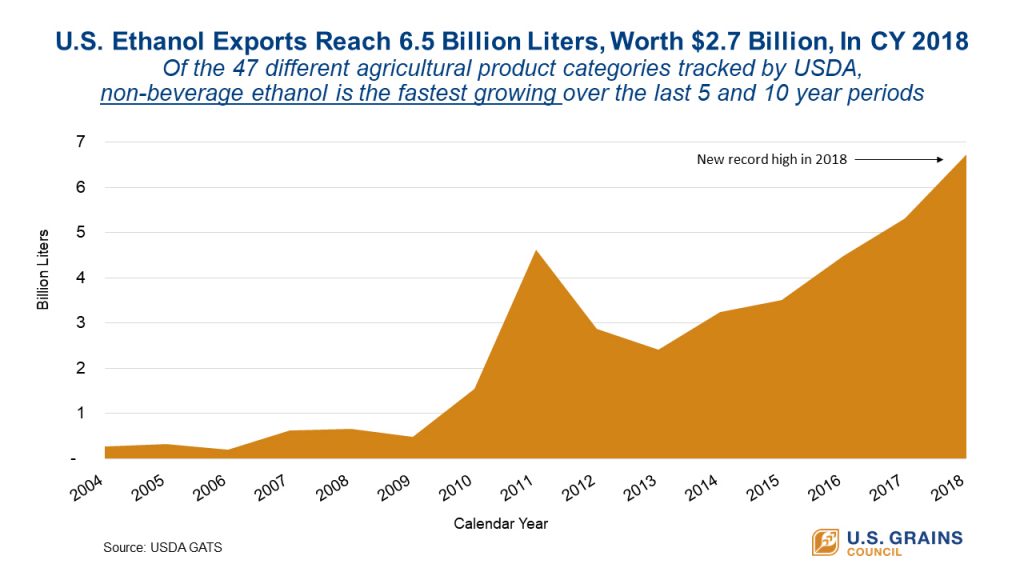A recent analysis by the U.S. Grains Council (USGC) shows non-beverage ethanol has been the fastest growing U.S. agricultural export over the past decade by a significant margin.
In 2018, U.S. ethanol exports totaled more than 6.5 billion liters (1.72 billion gallons or 609 million bushels in corn equivalent), valued at $2.7 billion. Using trade data on 47 different agricultural and ag-related product groupings tracked by the U.S. Department of Agriculture’s Foreign Agricultural Service (USDA’s FAS) via its Global Agricultural Trade System (GATS) system, analysis reveals the volume of ethanol exports grew by 18 percent per year over the past five years and 13 percent per year over the past 10 years.
Growth for each group was calculated on a fitted five- and 10 year-trendline and then adjusted for volatility. Of the 47 groups evaluated over the past five years, 21 showed negative growth over the period. The rest increased, but at a slower rate than ethanol.
These data track with increasing ethanol trade globally and demonstrate why ethanol market development is so important to U.S. farmers and ethanol producers.
“Ethanol is the perfect candidate for foreign market development since few countries fully understand the multitude of benefits that comes from blending it into gasoline,” said Mike Dwyer, USGC chief economist, who leads the Council’s global ethanol effort.
In another sign of competitive strength, the U.S. share of world ethanol exports reached a record 61 percent in 2018, up from only 9 percent a decade ago. Over this period, the United States has gone from the world’s largest ethanol importer to the world’s largest exporter.
In 2014, the Council began carrying out foreign market development activities in partnership with USDA’s FAS, Growth Energy, the Renewable Fuels Association (RFA) and state corn organizations. While small at first, the effort has grown to a true global effort with activities in 40 different markets funded by by the ethanol industry, corn growers and export promotion programs in the farm bill and administered by USDA’s FAS.
Most of this ethanol is for fuel blending purposes, although ethanol’s use in industrial applications is significant and growing as well.
“At the end of the day, foreign market development is about educating buyers and policy-makers overseas on the complete value proposition conveyed by the product – in this case, ethanol,” Dwyer said.
“Our ethanol program focuses on how ethanol blending at E10 or higher can reduce the carbon intensity of finished fuel that many countries seek, has fewer emissions associated with air pollution, fewer threats to human health and with an octane value so high that U.S. ethanol is now the lowest-priced octane in the world, compared against other countries’ ethanol as well as fossil fuel alternatives. This offers motorists tangible fuel savings when blended optimally into their gasoline.”
Find the latest available data on ethanol exports in the Council’s Feed Grain In All Forms Portal.
About The U.S. Grains Council
The U.S. Grains Council develops export markets for U.S. barley, corn, sorghum and related products including distiller’s dried grains with solubles (DDGS) and ethanol. With full-time presence in 28 locations, the Council operates programs in more than 50 countries and the European Union. The Council believes exports are vital to global economic development and to U.S. agriculture’s profitability. Detailed information about the Council and its programs is online at www.grains.org.

